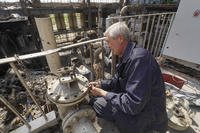 This article first appeared in Defense Technology International.
This article first appeared in Defense Technology International.
A strong argument could be made that given the recent innovations in ground-vehicle armor, and vehicle-mounted communications and sensor equipment brought about by the wars in Iraq and Afghanistan, the U.S. military is in a "Golden Age" for tactical vehicles.
It's jarring to think that just a few years ago, U.S. forces entered Iraq in thin-skinned, often doorless or roofless Humvees, vehicles that now seem more appropriate for museums than combat zones. The unforeseen needs of extra armor, especially underbelly armor to deflect roadside bombs, and the exponentially greater power-generation requirements of a force that increasingly relies on sensors and communications gear, has strained the fleet to its limits, and led to a revolution in vehicle technology.
Many of the changes this has spawned can be seen in two new development projects: the Joint Light Tactical Vehicle (JLTV), envisioned as the battlefield replacement of the Humvee, and the Mine Resistant Ambush Protected (MRAP) All-Terrain Vehicle (M-ATV), an interim replacement for Humvees in the rugged terrain of Afghanistan until the JLTV is fielded in 2015.
But while the attention of the military and industry is fixed on these two designs, with their electronics, sturdier suspension systems, lightweight composite armor and increased payloads, Brig. Gen. Brian Layer, commander of the Army's Transportation Center, calls attention to the Expanded Capacity Vehicle-2 (ECV2) from AM General, an upgraded and improved Humvee that he says is the "middle piece" that will get the military through until the JLTV is fielded. The ECV2 incorporates lessons learned in Iraq and Afghanistan, and so offers better power production capabilities, an engine moved forward, raised profile, more room in the crew compartment and electronic controls -- features that take into account the growing power needs and space requirements of sensors and communications gear.
The ECV2 isn't slated to hit the dirt until 2010, but one selling point is that it provides the same 3,500-lb. payload Humvees had before being weighed down with bolt-on armor in-theater. For whatever reason -- probably due to its flashier JLTV, MRAP and M-ATV cousins -- the ECV2 has been largely ignored in the rush to get new vehicles to troops in the field. Considering that it comes in at roughly half the cost of the JLTV (but without most of its technological upgrades and cutting-edge armor), it seems to be a capable vehicle that might get another look in budget-conscious times.
Throwing a little drama into the mix, Marine Corps Commandant Gen. James Conway warned in April that the service would not participate in the JLTV program if prototypes do not get lighter. The Marine Corps, he said, "will not buy a vehicle that's 20,000 lb." Depending on what the "evolution of development looks like, we may have to depart that buy and rehabilitate what we've got," Conway said. But to add all of these capabilities to existing or in-development programs requires the vehicles to produce much more electrical wattage than they have been able to generate. Requirements for the JLTV, for example, call for each vehicle to have a 30-kw. generator.
Michael Gallagher, program manager for expeditionary power systems for the Marine Corps, says the service is trying to meet the need for juice by retrofitting 400-amp. alternators with reduced-diameter pulleys on Humvees to generate more electricity. "One of the key incentives for this was that more power is needed, but more power was really needed at lower speeds, when vehicles are idling, or [moving slowly]," he said at a tactical vehicle conference in April.
Gallagher reported that his office received economic stimulus funding for the project, and is using the cash to bring the system to a reasonable level of maturity before turning it over to industry later this year in an open competition, with the goal of testing it in 2010 and 2011. Gallagher admitted, though, that "400 amps can only get us so far for so long -- in the future 400 amps will not be enough power," especially considering that he was talking about DC power. One approach the Marines are looking at is giving Humvees 20 kw. (800 amps) of onboard power.
To put this in perspective, when Humvees were first fielded in the 1980s, they had 60-amp. alternators. Compare that to the 600-800-amp. alternators the M-ATV and JLTV are expected to use. But even that exponentially enhanced requirement, Gallagher admitted, might not be enough on a future battlefield. Vehicles today are expected to support a mix of military and commercial off-the-shelf electronics, he said, all with different power requirements. And the need will grow.
There is concern as well in the Stryker vehicle community about power generation. The 8 X 8 infantry vehicle, made by General Dynamics, doesn't generate enough power to run all of its electronics simultaneously, according to Robert Hobbs, deputy capability manager at the Army's Training and Doctrine Command. The vehicle uses an analog system, which the Army wants to replace with digital technology.
Hobbs also spoke about suspension issues the vehicle could face if more armor is added to an already-stressed frame, which is "at the edge" of the weight the suspension system can accommodate. Originally designed at about 38,000 lb., with various armor packages Strykers now clock in at about 52,000 lb. Program managers, as a result, are looking at a semiactive suspension to handle the weight.
All of this work on power generation and suspension gear, and meeting the urgent battlefield needs of Iraq and Afghanistan, is siphoning cash away from other vehicles. Hobbs said work on the Stryker M1133 Medical Evacuation Vehicle (MEV) was "moving forward," and General Dynamics had been given the go-ahead to build the MEV to replace M113s. That order, however, was put on hold. "We took the money that was scheduled to go into the 113 divesture and moved it to buy equipment for a Stryker brigade going to Afghanistan."
With all this movement across the wheeled tactical vehicle fleet, Col. Mike Smith, director of training doctrine and combat command at the Army's Armor Center, didn't inspire much confidence when he called into question the next big-ticket tactical vehicle, the JLTV. Smith told the conference that he's "not sure" if the Defense Dept. "has figured out what it really wants us to do with JLTV yet. The lighter family of vehicles crapped out on us and is no longer cost-effective." He said the Defense Dept. is trying to get ahead of the issue, "but I'm not sure if we've figured out what it is we want in terms of" how the vehicle should perform in combat.
Read the rest of this story, check out spooky Skunk Works' plastic plane, debate the cost of cancelling the Raptor and check out the KillerBee's tour de France from our friends at Aviation Week, exclusively on Military.com.
-- Christian








